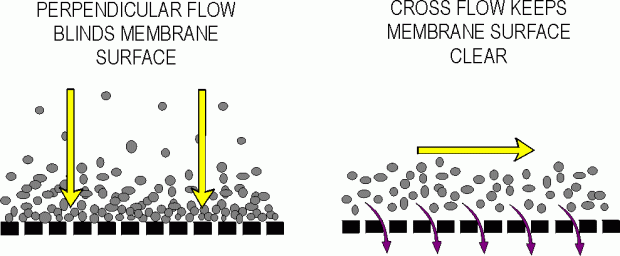Filtration methods
Earth filtration
Earth filtration uses DE as the filter medium, and takes place in two stages:
- Pre-coating: a layer of coarse grade earth is deposited on a supporting screen made of nylon or stainless steel.
- Filtration: earth is mixed into the wine and the mixture is passed through the screen. This leads to a continuously replenished filtration surface.
Earth filtration is mostly by screening, though some adsorption takes place. Earth filters either have supporting plates or a rotating drum (rotary vacuum filters), through which the wine is sucked by a vacuum pump.
Pad filtration
The wine is passed across a filter pad made of cellulose, cotton, DE or synthetic fibres such as polyethylene. This method uses adsorption and screening and also sedimentation, inertia and turbulence.
Membrane filtration
This form of filtration uses a cartridge made of cellulose esters, polysulfonate, nylon, polypropylene or glass fibre. It works mostly by screening, though there is a little depth filtration. This method is used more for microbial stabilisation than clarification proper. It is most commonly used as the last filtration before bottling.
Cross-flow filtration
The wine is passed along the surface of a porous membrane with sufficient pressure to force liquid through the pores. This parallel feed prevents clogging, but as the wine is being pumped around a partially closed circuit, the particle concentration increases. This method can be used for musts or wines with high particle concentrations, and is also adapted for ultrafiltration (de-alcoholisation), and reverse osmosis (concentration).
The above diagram is by David Bird MW from “Understanding Wine Technology”
Ultrafiltration
A cross-flow system using a membrane with a nominal relative molecular weight cut-off of 10,000. This will remove large phenolics and proteins thus potentially improving palatability and increasing the stability of the wine.
Reverse osmosis
Reverse osmosis (RO) is used for de-alcoholising wine. Wine is passed along a membrane (cross-flow) with very small pores which will only allow small uncharged molecules such as water, methanol, ethanol, acetic acid, ethyl acetate and acetaldehyde. Any dissolved ions or molecules with a relative molecular mass of more than 200 cannot pass through. The wine must be subjected to a pressure that is high enough to counteract the force of osmosis which acts in the opposite direction. Dry wine has an osmotic pressure of 14 bars, and so RO systems can pump wines at up to 40 bar. As the wine concentrates, its osmotic pressure increases, and so it is diluted with water so that as much alcohol as necessary can be extracted. This water should come from the original wine (extracted from the filtrate by distillation) for the wine to retain its designation of origin, grape variety and vintage. Total inert gas blanketing and low temperatures are used so the wine retains flavours. Systems used are quiet and fully automated.
Osmotic distillation
This is used for the production of high quality grape juice concentrates. Juice is passed on one side of a Polytetrafluoroethylene (PTFE or Teflon) membrane with high strength sodium chloride solution on the other side. The membrane is gas-permeable and so vapour can pass through. The differences in osmotic and hydraulic pressures causes water vapour to pass from the juice through the membrane and into the brine. The salt solution is being continually re-concentrated by a de-salinator. This method is characterised by low operating temperature and pressure, long membrane life and no browning or oxidation of the product
Flotation
Flotation is used solely for clarifying musts. Carbon dioxide or nitrogen gas and fining agents such as gelatine, bentonite and silica sol are injected into the must under pressure, and then the pressure is released. The gas comes out of solution and adheres to the solid particles, thus making them rise to the top of the vessel. These solid particles can then be removed physically (e.g. by a vacuum) or decanted from the juice and passed through a press filter or RDV.
